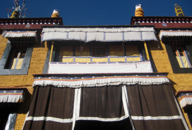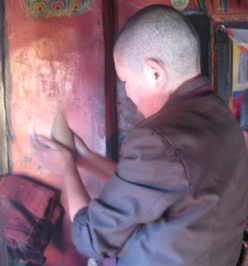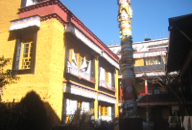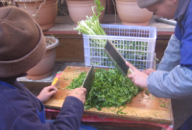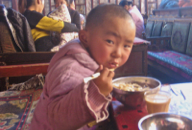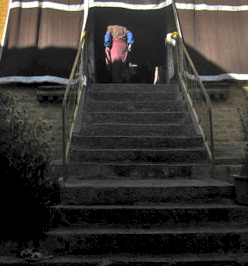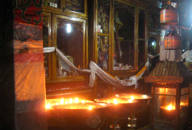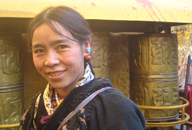ani tsang kung nunnery
Central LHasa
eastern Tibet, China
November 26, 2009


ani tsang kung nunnery
Central LHasa
eastern Tibet, China
November 26, 2009


I just loved visiting the Tsamkhung Nunnery, with no expectations. After visiting many monasteries, where the monks are busy with studies, writing mantras, and chanting, the beehive of activity found here was a welcomed contrast. That is not to say that the nuns don’t also chant and write scriptures, but it does mean that they seem to be more engaged with the people in the neighborhood. Upon walking in, the first thing I noticed was the tea room, segregated from the rest of the nunnery with a chest-high partition of fabric, decorated with Buddhist symbols. The next thing I noticed was a woman in an apron, a nun with shaved head, gingerly carrying a soup bowl of yellow melted butter (it looked like chicken broth) to the Assembly Hall, to be used to fashion butter lamps. Henry and I were told to walk clockwise through this hall, where a large contingency of nuns were chanting, their hair close cropped and all wearing red robes. We were encouraged to take photographs, even in the dark! As we wandered along the perimeter, we saw many nuns in aprons fashioning coin-sized lamps of solid butter. Toward the back, there were glass cases with images of Buddha, fronted by butter lamp altars aglow in the dark. On the third side of the square room, we saw many nuns fashioning stupa-shaped butter lamps, which I was later told sold for about 3,500 Chinese Yuan, a fortune in this neighborhood. Outside, we were pulled to a comfortable table by our guide, who had already ordered a thermos of sweet tea for us. This black tea is pre-mixed with sugar and milk. We chose not to drink an alternative tea, the Tibetan butter tea, which is made from yak butter and hot water, since the unappetizing smell of yak butter had haunted us throughout our monastery tours. As we drank our delicious tea, we made eye contact with many of the locals sitting around us. One three year-old amazed me with her deft ability to eat noodles with chopsticks. Many people were interested in seeing our eyes, an anathema to the dark eyed Tibetans who thought we were exotic! I photographed two women in blue aprons rhythmically chopping vegetables with meat cleavers, and watched as a woman using a water pump, wash vegetables that were piled high in a huge strainer. The positive, loving atmosphere created by this group of nuns created a place of comfort and safety for the entire neighborhood: men, women and children, locals and tourists alike. I was able to photograph a beautiful Tibetan woman turning the prayer wheels on her visit to the nunnery, an unusual occurrence, since most of the Tibetans are very camera shy.
PHOTOS: Left Column: 1. The Assembly Hall and Chapel at Ani Tsang Kung Nunnery. 2. Inside the building, where a gathering of nuns chant mantras together. 3. A three-year old child using chopsticks! This is indeed unusual, as most children begin this around the age of 6. Mother and child were at the nunnery restaurant having dinner. 4. The restaurant pavilion, shielded by the Buddhist cloth, decorated with symbols. Center, Top: A nun molding a stupa-shaped butter candle. Center, Bottom: The stairway to the Assembly Hall and Chapel at the nunnery. Right Column: 1. View inside the nunnery compound. 2. Altar with butter lamps burning in the chapel of the nunnery. 3. A woman inside the nunnery compound, spinning prayer wheels. 4. Two nuns chopping vegetables with cleavers. They created a fun rhythm together on the wooden cutting board.

Simple Acts of Loving Kindness

